|
Concert Review
Marillac gathers KC's
finest for jazz benefit
By
Tom Ineck
KANSAS CITY, Mo.—September 28 marked a rare occasional, a milestone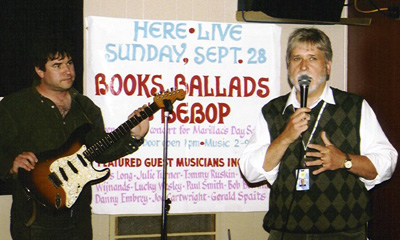 in the long and storied history of Kansas City jazz.
Nearly 30 of KC’s finest musicians gathered to perform a daylong benefit
at The Piano Room, a small club at 8410 Wornall Road in the city’s Waldo
district.
in the long and storied history of Kansas City jazz.
Nearly 30 of KC’s finest musicians gathered to perform a daylong benefit
at The Piano Room, a small club at 8410 Wornall Road in the city’s Waldo
district.
The players donated their talents for the cause, to help raise
a needed $21,000 to replace obsolete textbooks for Marillac Center’s therapeutic
day school. “Books, Ballads and Bebop” was expertly organized by Steve
Irwin, Marillac’s community relations director and the former co-director
of the late, lamented Kansas City International Jazz Festival. Also playing
important roles at the benefit were Irwin’s jazz fest co-directors, the
witty emcee John Jessup and the effervescent Jo Boehr, Irwin’s wife.
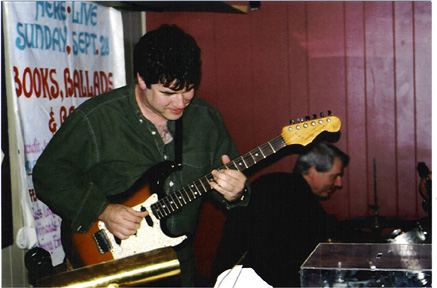 Festivities began modestly at 2 p.m. with vocalist Julie Turner and Turner’s
son, Brian Ruskin, on guitar. As the day progressed, musicians wandered
in to take the stage, reaching a crescendo of formidable jazz expertise
by the early evening and continuing until the final jam had played out at
10 p.m.
Festivities began modestly at 2 p.m. with vocalist Julie Turner and Turner’s
son, Brian Ruskin, on guitar. As the day progressed, musicians wandered
in to take the stage, reaching a crescendo of formidable jazz expertise
by the early evening and continuing until the final jam had played out at
10 p.m.
For this avid fan of Kansas City jazz, Ruskin was the first
of several surprises throughout the day. I suspect that many listeners
had similar feelings of good fortune, as an embarrassment of riches revealed
the talents of musicians not often heard together.
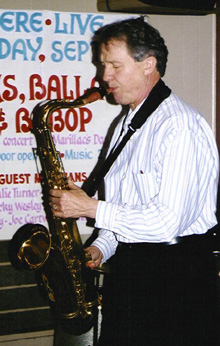 Ruskin is an outstanding guitarist, in both jazz and blues
styles, and a
sensitive accompanist to his mom on such
tunes as “Out of Nowhere,”
“Alone Together” and the samba “How Insensitive,” which was an excellent
vehicle for Turner’s throaty vibrato. Ruskin is an outstanding guitarist, in both jazz and blues
styles, and a
sensitive accompanist to his mom on such
tunes as “Out of Nowhere,”
“Alone Together” and the samba “How Insensitive,” which was an excellent
vehicle for Turner’s throaty vibrato.
Pianist Russ Long joined the duo for “All the Things You Are,”
and drummer Tommy Ruskin (Brian’s dad and Julie’s husband) later added
the shaded rhythmic pulse to “One Note Samba.” Long regaled the crowd with
his hilarious take on “My Old Kentucky Home.” Mike White, another pleasant
surprise, added his soulful tenor saxophone to a fast blues shuffle. Turner
capped the performance with “I Love Being Here with You.”
 Even before he took the stage to perform, traditional jazz pianist-singer
Bram Wijnands was enthusiastically documenting the historic event on his
video camera. His duo set with Scamps drummer Rusty Tucker was a joy, pitting
the young Dutch marvel with one of the elder statesmen of Kansas City jazz.
It was a hoot to hear Wijnands deliver a Dutch-inflected “She’s my ding
dong baby and she knows how to ring my bell,” then join Tucker for some
raunchy, blues tinged scat singing.
Even before he took the stage to perform, traditional jazz pianist-singer
Bram Wijnands was enthusiastically documenting the historic event on his
video camera. His duo set with Scamps drummer Rusty Tucker was a joy, pitting
the young Dutch marvel with one of the elder statesmen of Kansas City jazz.
It was a hoot to hear Wijnands deliver a Dutch-inflected “She’s my ding
dong baby and she knows how to ring my bell,” then join Tucker for some
raunchy, blues tinged scat singing.
Tucker turned in a pair of warm vocals on “All of You” and
“What a Wonderful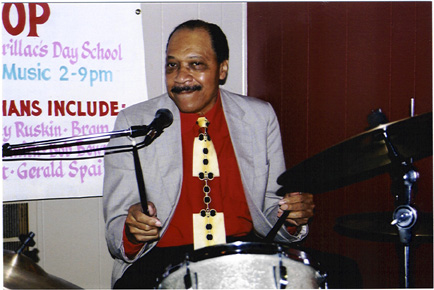 World,” but it was Wijnands’ Fats Waller-inspired playing
and singing on Waller’s “Honeysuckle Rose” that was most impressive. His
rollicking, wide-open keyboard attack had feet tapping and fingers snapping.
The duo also dedicated a sensitive version of “Sentimental Journey” to club
owner Dean Weiss, who generously contributed the day’s profits to Marillac.
World,” but it was Wijnands’ Fats Waller-inspired playing
and singing on Waller’s “Honeysuckle Rose” that was most impressive. His
rollicking, wide-open keyboard attack had feet tapping and fingers snapping.
The duo also dedicated a sensitive version of “Sentimental Journey” to club
owner Dean Weiss, who generously contributed the day’s profits to Marillac.
Pianist Paul Smith fronted a marvelous quartet also featuring guitarist
Danny
 Embrey, bassist Bob Bowman and drummer John Doubleday. Tunes included
an uptempo “Yesterdays,” “O Pato (The Duck),” and a reprise of “All the Things
You Are.” Embrey was loath to leave early, but he was due to board a flight
the next morning to join singer Karrin Allyson for a European tour that
included stops in Rome and Paris. Embrey, bassist Bob Bowman and drummer John Doubleday. Tunes included
an uptempo “Yesterdays,” “O Pato (The Duck),” and a reprise of “All the Things
You Are.” Embrey was loath to leave early, but he was due to board a flight
the next morning to join singer Karrin Allyson for a European tour that
included stops in Rome and Paris.
The momentum continued to build with the arrival of pianist
Joe Cartwright,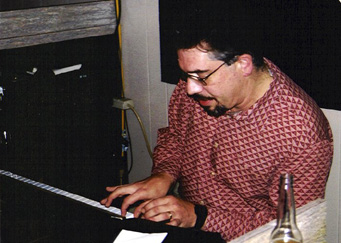 bassist Gerald Spaits and drummer Ray DeMarchi, a very compatible trio
of veterans. Never satisfied with conventional interpretations, Cartwright
and company chose a samba by trumpeter Claudio Roditi and the underappreciated
standard “Whisper Not,” before putting a definitive blues tinge to the
timeless ballad “September Song,” building to the astonishing piano crescendo
and the soulful climax for which Cartwright has become known.
bassist Gerald Spaits and drummer Ray DeMarchi, a very compatible trio
of veterans. Never satisfied with conventional interpretations, Cartwright
and company chose a samba by trumpeter Claudio Roditi and the underappreciated
standard “Whisper Not,” before putting a definitive blues tinge to the
timeless ballad “September Song,” building to the astonishing piano crescendo
and the soulful climax for which Cartwright has become known.
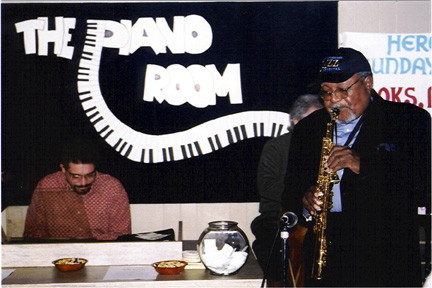 Kansas City legend Pete Eye replaced Cartwright at the piano for a stunning
rendition of Paul Desmond’s “Take Five.” Eye’s affinity for Dave Brubeck
was immediately evident in his classical constructions and syncopated phrases.
Kansas City legend Pete Eye replaced Cartwright at the piano for a stunning
rendition of Paul Desmond’s “Take Five.” Eye’s affinity for Dave Brubeck
was immediately evident in his classical constructions and syncopated phrases.
Backed by Cartwright, Spaits and DeMarchi, Ahmad Alaadeen
delivered one of the highlights of the day, a set that included a spirited
romp through Juan Tizol’s “Caravan,” featuring Alaadeen on soprano sax.
Trumpeter Stan Kessler, alto saxophonist Kim Park and drummer
Doug
Auwarter joined the fray with Cartwright and Spaits on a special request
from
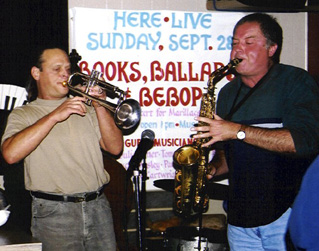 Irwin, the lively “Lester Leaps In.” The classic bop changes received
a round of exemplary solos by Kessler, Park and Cartwright, each one building
in intensity and innovation and ending with Park mimicking Lester Young’s
famous sideways stance and Kessler valving the trumpet upside down! Irwin, the lively “Lester Leaps In.” The classic bop changes received
a round of exemplary solos by Kessler, Park and Cartwright, each one building
in intensity and innovation and ending with Park mimicking Lester Young’s
famous sideways stance and Kessler valving the trumpet upside down!
Joe Zawinul’s funky anthem, “Mercy, Mercy Me,” was taken at
a slow and soulful tempo, punctuated by moving solos by Park and Kessler.
Park closed the set with “Centerpiece,” taking the vocal chores as well
as delivering a bluesy alto solo, segueing into stop time and an exhilarating
double-time finale.
In the wake of this electrifying performance, Jessup took
the microphone to remind us again that this was “a singular day in Kansas
City jazz.” No one could argue with that assessment.
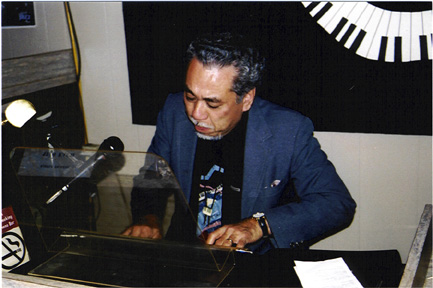 As the evening began to wind down, pianist and singer Mike Ning took
the stage with bassist Tim Brewer and drummer Mike Shanks for yet another
version of “All the Things You Are,” followed by “Everything Happens to
Me.” Sherry Jones capably vocalized on the uptempo “Ornithology/How High
the Moon,” on which Ning’s solo cleverly referred to “Surrey with The Fringe
on Top.” Young aspiring drummer Timothy Ning made it a family affair when
he joined dad Mike and mom Sherry for a rhythmic run through the Herbie Hancock
favorite “Watermelon Man.”
As the evening began to wind down, pianist and singer Mike Ning took
the stage with bassist Tim Brewer and drummer Mike Shanks for yet another
version of “All the Things You Are,” followed by “Everything Happens to
Me.” Sherry Jones capably vocalized on the uptempo “Ornithology/How High
the Moon,” on which Ning’s solo cleverly referred to “Surrey with The Fringe
on Top.” Young aspiring drummer Timothy Ning made it a family affair when
he joined dad Mike and mom Sherry for a rhythmic run through the Herbie Hancock
favorite “Watermelon Man.”
It was a hipster’s holiday when David Basse joined vocals
with pianist Greg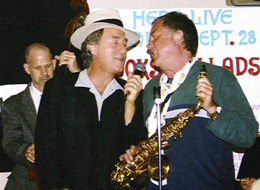 Richter and bassist Brian Hicks for Bobby Timmons’ “Moanin’” and another
rendition of “Centerpiece,” which also featured Park on alto sax.
Richter and bassist Brian Hicks for Bobby Timmons’ “Moanin’” and another
rendition of “Centerpiece,” which also featured Park on alto sax.
The distinguished and gentle presence of pianist and singer
Luqman Hamza brought the proceedings to a close. The local legend caressed
the keys as he gave new life to the lyrics of “Falling Love with Love,”
“My One and Only Love” and, best of all, “I Will Understand.” It was a display
of grace and class that could serve as a lesson to all jazz musicians.
 The day’s events stand as a remarkable example of artistic camaraderie
and might serve as a model for Marillac’s vision statement: “To see at-risk
children and families become contributing members in their communities
by modeling a caring, nurturing and learning environment and by providing
innovative, professional treatment and support.”
The day’s events stand as a remarkable example of artistic camaraderie
and might serve as a model for Marillac’s vision statement: “To see at-risk
children and families become contributing members in their communities
by modeling a caring, nurturing and learning environment and by providing
innovative, professional treatment and support.”
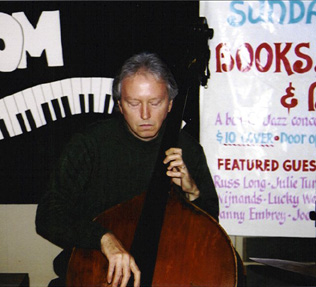 “Books, Ballads and Bebop” certainly created a caring, nurturing
and learning
environment for the hundreds of jazz fans who turned out to support
a very worthy cause. “Books, Ballads and Bebop” certainly created a caring, nurturing
and learning
environment for the hundreds of jazz fans who turned out to support
a very worthy cause.
To learn more about Marillac Center and how you can help the
cause, call Steve Irwin at (816) 508-3311 or write to Marillac at 2826
Main St., Kansas City, Mo. 64108.
top
|
Dance
Review
"Sierra Latina"
is Latin dance at its best
|
By Tom Ineck
KANSAS CITY, Mo.—Latin dance, by its nature, is a colorful, sensual and exhilarating expression of emotions. At its best, it is poetry in motion
and a panoramic parade of life’s joys and sorrows.
exhilarating expression of emotions. At its best, it is poetry in motion
and a panoramic parade of life’s joys and sorrows.
Latin dance was at its best Sept. 27 at the Kansas City Music Hall for
“Sierra Latina: A Latin Evening of Dance.” The performance was presented
by Rite of Danse, a local non-profit arts organization whose goal is to
create and present dance productions that utilize multiple art forms and
honor cultural differences.
Artistic Director Liz Jeans of Rite of Danse organized the event, bringing
together various groups to perform dance and music from Mexico, Brazil,
Argentina, Spain and the United States. Cultural differences were most obvious
as the medley of costumed dancers, in turn, took the stage to the music
of salsa, samba, flamenco, folkloric dance, tango, Latin jazz dance and
modern dance.
Fiesta Mexicana took the lead with “Nayarit,” a traditional folkloric
presentation with choreography by the group’s director, Rose Marie Mendez.
The flair of colorful skirts and the flash of machetes in a sort of “sword
dance” combined to create a stunning opener.
“Hoy Es Adios,” by the Signature Dance Company with choreography by Loren
Whittaker, was a typically sensual display with lacy scarves serving as
enticing props. “Sevillanas to Bulerias” was a multimedia
flamenco tour de force by Ole Music and Dance of Spain, choreographed by
Tamara McIntosh, artistic director of Ole. The colorful music of guitarist
Raul Gomez accompanied dancers, some in stark black-and-white costumes and
others in bright dresses. Castanets and double-time flamenco clapping added
to the excitement.
Jeans and her partner, Michelle Powers, choreographed and danced the
interpretative “Nuestra Contribucion Con Carina,” with a passionate and
impressionistic flair. With legs that seem to go on forever, Jeans seems
to project her body in several directions simultaneously, reacting instantly
and dramatically to unseen rhythmic impulses.
The American influence on Latin dance was most apparent in the “Latin
Ballroom Suite,” performed by a passing array of male-and-female partners,
from Louis Barr and Rebecca Rodriguez doing “Paso Doble” to Frank Gillitzer
and Mallee Morris illustrating the “Cha Cha” to Rafael Labrado and Anya Berdichevskaya
with “Rhumba.”
Barr returned with Laura Cantu for “Tango,” followed by Labrado and Berdichevskaya
with “Samba,” Gillitzer and Morris with “Rhumba” and, finally, three couples
dancing a jive version of “Fever.”
“Neo Tango” was a bravura display of modern dance by the Wylliams/Henry
Danse Theatre Company. Inspired by the music of Argentine tango composer
Astor Piazzolla and choreographed by Dee Anna Hiett and Dwight Rhoden, it
was a breathtakingly acrobatic performance.
The Latin Rhythm Dance Company, with choreography by Denisse Elise and
Josue Hernandez, danced “Where’s the Salsa?” a dazzling exhibition of style
and technique. Lighting designer Jim Primm created the appropriate dramatic
and atmospheric settings for each performance, and stage manager Beth Byrd
overcame the daunting logistical challenges of segueing from one dance
group to another.
The evening’s irresistible capper was a public dance across town at the
beautifully restored, Spanish-style Madrid Theatre, where we amateur hoofers
were allowed to share the floor with the professionals, to the spirited music
of jazz trumpeter Stan Kessler and the Sons of Brasil.
“Sierra Latina: A Latin Evening of Dance” was billed as a tribute to
Jose Gonzalez, founder of the annual Hispanic Fiesta at the Barney Allis
Plaza, started in 1985, and creator of “Sierra Latina.” Gonzalez recently
died, but his huge influence on Kansas City dance and the city’s Hispanic
culture remains obvious.
“Sierra Latina” also is a tribute to Jeans’ dedication and organizing
skills. She gathered together some of the best Latin dance ensembles available,
and the sheer volume and degree of talent was remarkable, even for a metropolis
of Kansas City’s size. Bravo!
See story below for more on Liz Jeans and "Sierra Latina."
top
Artist Interview
Liz Jeans a mover and shaker in KC dance
By Tom Ineck
Liz Jeans is a mover and a shaker—on the dance floor, in her community
and around the world.
Her Kansas City-based, non-profit Rite of Danse organization—through the
magic of dance—attempts to break down the barriers that separate people of
different ethnic groups, while celebrating their diverse cultural heritage.
Productions have combined fashion and dance at an exhibit of photographs
by Herb Rits, blended social dancing and staged choreography to the Latin
jazz sounds of Sons of Brasil and performed poetry and dance for a “Victory
over Violence” festival.
Rite of Danse also is the umbrella organization for Signature Dance Company,
a youth jazz dance company for dancers ages 12 to 21.
Very early in life, Jeans was inspired by Latin culture, and it left a
lasting impression on her dance styles, her choreography and her whole philosophy
of life.
“I was always drawn to that, and no one else in my family was. It was
probably from the time I was 12 or 13. It was just part of me,” she said
in a recent phone interview. “I enjoy being outside of my culture. I have
no Latin blood. I’m as Caucasian as it gets. I’m a white girl who appreciates
other cultures a lot. I feel our limitations and our fear of expressing
passion, that I find much more a part of Latin culture.”
Her Latin love affair extends well beyond the confines of the dance floor.
“I appreciate the passion and rhythms that you hear in Latin music and
all Latin art. I like Latin movies. I like Latin literature. I like Latin
music, and I like Latin dance.”
Latin dance, she found, helps to express emotions that are usually kept
hidden in the more reserved traditions of northern Europe. It also honors
life’s mysteries without trying to reduce everything to a scientific equation.
“We have every emotion, and we have things we can’t explain,” she said.
“We have things that aren’t concrete, and you’ve got to learn how to integrate
all of that.”
Raised in St. Louis and Kansas City, Jeans has a master’s degree in dance
from the University of Oregon. In Eugene, she developed a community center
for the performing arts program and co-directed Powers & Jeans Dance
Ensemble.
After a debut in Los Angeles, she began an international dance sojourn
in Baghdad, during the Iran/Iraq war. She moved to Paris, where she danced
at the historic Moulin Rouge. Based in Paris, she danced with Soho productions
in Tokyo and at the Friedreichstadt Palast in East Berlin before the fall
of the Wall.
In 1988, Jeans returned to Kansas City and taught dance in the KCMO Visual
and Performing Arts School for seven years. She remains a freelance choreographer,
teacher and performer as the founder and artistic director of Rite of Danse.
Jeans’ colleagues in Rite of Danse are out-of-town consultant Michelle
Powers and Loren Whittaker.
Powers and Jeans have a long history of working together. They met as
colleagues, directing separate community dance programs, and later formed
and directed Powers & Jeans Dance Ensemble. Their adventures took the
Eugene, Ore.,-based company to Los Angeles and Baghdad. Years later, they
ran a spa in Cabo San Lucas, Mexico, under Powers’ direction.
Powers recently moved back to Oregon after living in California for the
last 10 years. Despite the distance, Powers and Jeans still consult and
support each other on projects such as “Sierra Latina.”
Loren Whittaker is director of Signature Dance Company, sponsored by Rite
of Danse. Her choreography and support was a major part of “Sierra Latina.”
Now an adjunct professor of jazz dance in the UMKC dance department, she
has been a lead dancer in Las Vegas, Nev., and assisted with choreography
and direction of two TV programs in Rome.
top
|
|
Concert Review
Interstring defines jazz group dynamic
|
By Tom Ineck
As jazz combos come and go, few are allowed the longevity
to form a cohesive group dynamic. One of the rare exceptions is the Kansas
City-based quartet Interstring, whose compatibility and chemistry is increasingly
evident as they approach nearly a decade together.
That group dynamic was in full play during an Oct. 16 performance
at P.O. Pears in downtown Lincoln, funded by the Berman Music Foundation.
It was their sixth and final gig in a brief series of Midwestern appearances,
occasioned by the return visit of essential drummer Todd Strait from his
home in Oregon.
The other essentials in this fearsome foursome are guitarists
Danny Embrey and Rod Fleeman and bassist Bob Bowman. Over the past decade,
they have created and maintained a totally unique sound, whether playing
as a quartet or in support of singer Karrin Allyson, who appeared frequently
with them during her formative years in KC.
It didn’t take long for the band to start cooking at its recent
Lincoln show. Taking the first solo in the opener “You Stepped Out of a
Dream,” Embrey left the starting gate running with a dazzling display of
fretwork. Bowman followed with an authoritative and imaginative solo before
handing it off to the fleet-fingered Fleeman. Strait employed the full range
of his extensive percussion vocabulary, including a brief press roll.
Embrey’s composition “Samba 88” is always a joy to hear, but
seemed especially inspired and inspiring on this evening. It had the open,
breezy resonance of a Pat Metheny tune, with Strait’s polyrhythmic mastery
of the drums establishing an irresistible groove over which Fleeman, Bowman
and Embrey soloed with increasing intensity. Strait’s hand-drumming interlude
gave the piece the appropriate Latin tinge.
Even “One Finger Snap,” the dauntingly up-tempo Herbie Hancock
composition, seemed to flow with ease in Interstring’s polished rendition.
The guitars made the opening statement in unison, and Strait followed with
another astounding drum solo and continued to push the beat during alternate
solos by Embrey and Fleeman.
Jimmy Rowles’ lovely ballad “The Peacocks” seemed to gradually
emanate from the musicians with impressionistic flourishes as they constructed
the tune from Fleeman’s initial statement of the haunting melody. Embrey
entered with a solo combining single-string runs and unusual chords. Finally,
Bowman and Strait—on brushes—completed the group rapport. Bowman’s subsequent
bass solo was especially impressive.
Ending the set was the bassist’s own good-time tune, “The
Hebgen Happy Hour,” inspired by a lakefront bar in the wilds of Montana.
With elements of funk, blues and country twang, anchored by Strait’s brush-stroked
backbeat, it conjured an appropriately laid-back ambiance.
The popular Jean “Toots” Thielemans samba “Bluesette” was
highlighted by an adventuresome Fleeman solo. Bowman announced the debut
performance of a tune called “Notes and Chords,” featuring solos by Embrey,
Fleeman and the bassist. “Willow Weep for Me” was given an unconventional,
funky treatment that included some imaginative Fleeman variations and a brilliant
guitar exchange.
Bowman’s pen also yielded the night’s final piece. Named for
the family pet, the tune’s Spanish title is translated “Dog of the Devil.”
The opening bass solo was ominous, setting up intricate, weaving guitar
lines and a marvelous Latin rumble of a drum solo.
Despite the small audience turnout, Interstring performed
at the highest level of art, never failing to deliver on its many years of
promise and hard work.
top
|
Concert
Review
Marsalis proves drawing power and talent
|
By Tom Ineck
In the jazz world, only a handful of artists have the drawing
power to fill the 2,200-seat Lied Center for Performing Arts with an enthusiastic
and multigenerational audience.
Wynton Marsalis, fronting the Lincoln Center Jazz Orchestra,
did just that on the evening of Oct. 14, and the 15-piece ensemble did
not disappoint.
In its 10-year tradition of keeping alive some of the important
works of jazz history, as well as performing and recording its own compositions,
the Lincoln Center band began with the Charles Mingus bopper called “Dizzy
Moods.” It has a typically intricate, polyrhythmic construction, with shifting
tempos reinforced by the masterful drumming of Herlin Riley.
Turning to John Coltrane, the orchestra played the “Resolution”
section of the suite “A Love Supreme.” After a beautifully organic bass
statement by Carlos Henriquez, Wess Anderson delivered an alto sax solo
that aspired to profound musical expression in the same way that Coltrane’s
version aspired to spiritual expression. Pianist Eric Lewis followed with
a powerful solo reminiscent of McCoy Tyner, with left-handed block chords
and blazing right-hand runs.
They returned to the Mingus songbook for “Los Mariachis (Street
Musicians),” a showcase for trumpeters Seneca Black and Ryan Kisor, who
delivered an astounding solo. Kisor, at 30, has come a long way since his
teenage years as guest soloist with the Nebraska Jazz Orchestra.
Ending the first half of the two-hour program was Thelonious
Monk’s “Four In One,” arranged for the orchestra by Chuck Israels. Marsalis
made a bravura opening trumpet statement with the rhythm section only.
Suddenly, the rest of the band launched into a rousing New Orleans street-parade
version of “Happy Birthday.”
Their leader’s 42nd birthday is Oct. 18, but this was the
final stop on the current tour, so they paid their respects a few days early.
Marsalis good-naturedly responded by soloing in grand style.
For the second half, eight members of the ensemble took the
stage for a piece constructed around a lilting phrase repeated in a circular
motion and featuring brilliant solo statements by Marsalis, Victor Goines
on tenor sax, Walter Blanding Jr. on tenor sax and Lewis on piano.
The full orchestra played a piece from “Victoria Suite,” commissioned
by a festival in the Basque region of Spain. Trombonists Ron Westray, Andre
Hayward and Vincent Gardner each took solos, but it was Riley’s constant
rhythmic underpinning that most impressed.
George Gershwin’s “Rhapsody in Blue,” as arranged by Billy
Strayhorn for the Duke Ellington Orchestra, was perhaps the evening’s highlight.
As just six minutes, it was less than half the length of Gershwin’s original,
but it packed a wallop from the opening passage by Joe Temperley on baritone
sax to Kisor’s plunger-muted melody line. Near the end, Goines on clarinet
played the famous slurred run that usually opens the Gershwiin classic.
“Big 12” was an original composition with elements of both
the blues and flamenco structure.
This review initially appeared in the Lincoln Journal Star.
top
|
Concert Review
Mahogany fronts Nebraska Jazz Orchestra
|
By Tom Ineck
“Standards, Scat and Soul” was the theme of the program, and
the Nebraska Jazz Orchestra with special guest vocalist Kevin Mahogany,
provided plenty of each Oct. 1 at the Lied Center for Performing Arts.
A Kansas City, Mo., native with a sonorous, full-bodied tone
in the tradition of Joe Williams and Billy Eckstine, Mahogany wraps his
deep-throated voice around a lyric with warmth and blues-drenched emotion.
He was in his element, working his way through a set of charts
he brought along just for the occasion. Performing for an audience of 350,
the NJO showed its quick-study skills with capable accompaniment and on-the-spot
solos.
Before Mahogany took the stage, the band shifted into high
gear for Toshiko Akiyoshi’s fast blues shuffle “Tuning Up,” a favorite
warm-up piece that puts the brass through the paces.
At a similar up-tempo, Mahogany began his set with “There
Will Never Be Another You,” launching into a heated scat interlude after
the first verse. In the same spirit, Darren Pettit contributed a fiery tenor
sax solo.
Best known for its association with Frank Sinatra, the ballad
“One for My Baby” received a sensitive reading by Mahogany in a Frank Mantooth
arrangement that also featured muted trumpet statements by Brad Obbink
and a baritone sax solo by Scott Vicroy.
With just the rhythm section, Mahogany turned his attention
to the Ellington songbook, with a mid-tempo rendition of “Don’t Get Around
Much Anymore” and a rollicking “Take the A Train.” On the former, he displayed
his vocal pyrotechnics over a several-octave range, and the latter featured
more amazing scat-singing and some percussive trades between the singer
and drummer Greg Ahl.
The orchestra closed the first half of the program with “Lester
Jumps Out,” a swinging variation on Lester Young’s classic “Lester Leaps
In.”
Dizzy Gillespie’s “Tanga” got the second half off to a rousing
start, and guitarist Peter Bouffard’s imaginative arrangement of “Danny
Boy” received another fine reading by the orchestra.
Mahogany paid homage to Joe Williams with “In the Evening,”
a bluesy swinger highlighted by the singer’s swooping upward flight from
the bottom to the top range without a fault. “Fools Rush In,” a nod to Billy
Eckstine, got a Latin treatment.
Once again fronting the rhythm section, Mahogany deftly motored
through an uptempo version of “Route 66,” followed by the ballad “When
I Fall in Love,” and the Miles Davis burner “Four.”
After the full orchestra returned to the stage, Mahogany’s
lyrics were put to the music of Paul Hoffman for the lovely, Latin-tinged
“Three Little Words.”
Finally, Mahogany and company barreled through Charlie Parker’s
“Yardbird Suite,” with Ed Love taking Bird’s role on alto saxophone.
This review initially appeared in the Lincoln Journal Star.
top
Concert
Review
Capers and companions
keep tradition alive
|
By Bill Wimmer
Valerie Capers performed with her jazz quartet Sept. 21 at
Doane
College's Heckman Auditorium. Capers,
who's played at Doane before, was capping off
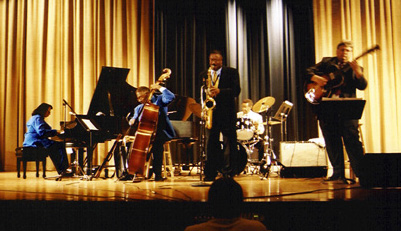 a short residency and workshops
with students with a concert for a very enthusiastic crowd. a short residency and workshops
with students with a concert for a very enthusiastic crowd.
Her quartet included Alan Givens on tenor sax; John Robinson,
bass; Earl Williams, drums; and Mark Marino, guitar. This veteran group,
sans Marino, has been together for years and it showed from the first note.
While Capers is a really fine pianist, she spends much time promoting and
featuring her excellent companions.
Opening with “Take the ‘A’ Train,” Givens led off, quoting
“Exactly Like You” and displaying a great sound and wealth of ideas. Guitarist
Marino followed with a Wes Montgomery-inspired, octave-building flight
of his own. The leader showed her command of the jazz piano lexicon by
incorporating bop, boogie woogie and much in between, all anchored by her
tasteful chords from a very solid left hand. The bassist and drummer Williams
each made their own statements as the song was brought to a rousing end.
Horace Silver's “Sister Sadie” was taken at a slower, funkier
tempo than the original. Givens soloed first, followed by bluesy Marino,
Capers and Robinson. The song ended with an interesting arrangement that
showcased Givens at the finale.
 The trio of Capers, Robinson and Williams then played “Everything Must
Change.” Although I was a little hesitant at the announcement of this really
overworked number, it took on a whole new life with Caper's great version.
Moving from a Bill Evans feel on the theme, she took it into an up-tempo
modal section interlude after the bridge that was really refreshing. The trio of Capers, Robinson and Williams then played “Everything Must
Change.” Although I was a little hesitant at the announcement of this really
overworked number, it took on a whole new life with Caper's great version.
Moving from a Bill Evans feel on the theme, she took it into an up-tempo
modal section interlude after the bridge that was really refreshing.
Paying tribute to Ellington most of the evening, “Caravan”
was up next, with drummer Williams taking the spotlight. He started on
high hat and then snare, using space and dynamics to great effect, without
losing the feel of the tune. Building up to a great climax, he worked
the solo and the student-heavy crowd into a frenzy.
Next up was seldom heard Ellington's “Circle of Fourths,”
which featured a whirling Givens on tenor and culminated with a nice cadenza.
Givens, who received a standing ovation, is a real entertainer who seems
to have a bit of Sammy Davis Jr. to him.
Guitarist Marino was given the honors on “Prelude to A Kiss,”
and he made the most of it with a finger-picking intro and melody. Switching
back to a pick for his solo and going back to a beautiful chordal ending
and a pretty ending and cadenza, Marino is a welcome addition to this group.
More Ellingtonia commenced with a medley of “C-Jam Blues,”
“Cottontail” and “It Don't Mean a Thing.” “Cottontail” featured a two-beat
stride piano section, taking off up-tempo at the bridge. “It Don't Mean
a Thing” ended the first set with great statements from Marino and Givens.
The second set started with Capers, seated on a stool out
front, singing an up-tempo “From This Moment On.” She then sang Strayhorn's
melancholy “Lush Life,” followed by “Nature Boy,” two ballads that picked
up slightly during a rich Given's solo on the latter.
up-tempo “From This Moment On.” She then sang Strayhorn's
melancholy “Lush Life,” followed by “Nature Boy,” two ballads that picked
up slightly during a rich Given's solo on the latter.
The combination of Caper's relatively small voice, the slower
tempos and the lack of her fine piano playing made this a really slow part
of the evening after such an energetic first set. I think three numbers
from someone of her vocal ability is a bit self-indulgent.
She settled back in the piano chair for a breakneck ride on
“Oh, What a Beautiful Morning.” This one was so fast that Marino, a chopsmeister,
still turned the time around playing himself into a corner on his second
chorus.
Bassist Robinson was featured on “Mood Indigo,” and he wasted
no time displaying his complete mastery of the instrument. Bowing, picking,
slapping, playing chords and double stops to great advantage-not just for
technical effect. This guy is solid as a rock.
Finishing with “I Got Rhythm,” Givens quoted Blue Mitchell's
“Funghi Mama” and it was good naturedly picked up by the rest of the band.
It wasn't the first time they'd played it this way, but the group responded
to each other so naturally that it could have been. A quote from the “Flintstones”
theme brought
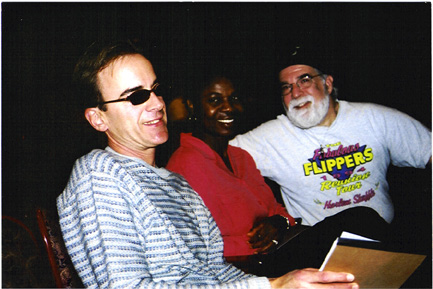 down the house again, and only my fatigue kept me from sticking
around for the encore. down the house again, and only my fatigue kept me from sticking
around for the encore.
Valerie Capers presents a world-class jazz group that
achieves its goal of keeping the tradition alive. Not having seen the group
before I was very impressed by all members and by the nice crowd at Doane.
The addition of Marino has added a lot to an already fine group, and it’s
not every day that Butch Berman gets blown away by a jazz guitarist. This
was a very enjoyable show and I would recommend seeing this group if you
get a chance.
top
Concert Review
Tropique launches 2003
Jazz in June series
|
By Tom Ineck
 Since the mid-1990s, the Jamaica-born composer, bandleader and
percussionist Norman Hedman has been captivating audiences with the
warmth and insistent rhythms of his tropical jazz juggernaut, Tropique. Since the mid-1990s, the Jamaica-born composer, bandleader and
percussionist Norman Hedman has been captivating audiences with the
warmth and insistent rhythms of his tropical jazz juggernaut, Tropique.
This summer, the New York City-based ensemble again ventured out to America’s
heartland for a Jazz in June performance sponsored by the Berman Music
Foundation. The June 3 show was the first in this year’s series of
outdoor concerts at the Sheldon Art Gallery’s sculpture garden on the University
of Nebraska-Lincoln’s city campus. It drew an estimated 2,200 people on
an unseasonably cool evening.
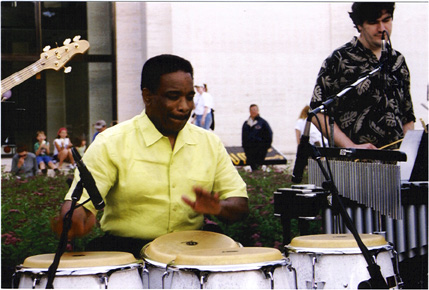 Tropique’s sound remains consistent, despite the departure of a couple
of its longtime members, a tribute to Hedman’s vision and leadership.
Tropique’s sound remains consistent, despite the departure of a couple
of its longtime members, a tribute to Hedman’s vision and leadership.
From the BMF-funded 2000 release “Taken By Surprise” came the concert
opener, the irresistible “Pa’ Bailar,” with strong solos by Sam Furnace on
alto sax and Craig Rivers on piccolo. Hedman led the percussion tour de
force on congas, and music director Willie Martinez poured on the heat with
an exciting workout on timbales.
“Rudy’s Mambo” was a showpiece for new vibes sensation Alexei Tsyganov,
brother of longtime Tropique pianist Misha Tsyganov. The young vibraphonist
contributed a lightning display of melodic improvisation. “It’s Just Not
the Same” began with a repeated piano vamp, leading to a combined alto sax
and flute lead line and a stunning flute solo by Rivers. With strong support
by bassist Ron Monroe, pianist Tsyganov dug deeply into the theme for some
exemplary keyboard variations.
 From the 1996 CD “Healing Hands,” the ballad “Forever” proved its timeless
quality. Again, it utilized a doubled melody line of alto sax and flute,
providing the basis for solos by both Tsyganov brothers. Special guest vocalist
Ada Dyer joined the group for “Closer.” Renowned for her work with pop artist
Sting and in the musical “The Wiz,” Dyer brings a huge voice—with soul
and gospel influences—to the stage, a nice contrast to Tropique’s lighter
approach. From the 1996 CD “Healing Hands,” the ballad “Forever” proved its timeless
quality. Again, it utilized a doubled melody line of alto sax and flute,
providing the basis for solos by both Tsyganov brothers. Special guest vocalist
Ada Dyer joined the group for “Closer.” Renowned for her work with pop artist
Sting and in the musical “The Wiz,” Dyer brings a huge voice—with soul
and gospel influences—to the stage, a nice contrast to Tropique’s lighter
approach.
Dipping again into his lengthy songbook, Hedman pulled out “Shades of
Magenta” from his 1999 BMF-funded CD “One Step Closer.” After a remarkable
piano solo, Rivers sounded especially inspired on a flute solo and cadenza
before turning it over to Furnace on alto sax.
Among the new material that Hedman unveiled was a piece of his inspired
by a “food frenzy,” a festive gathering of gourmands. Entitled “Feeling My
Way,” it exemplified the group sound that defines Tropique and sets them
apart from the often self-indulgent ramblings of other Latin jazz groups.
“Flight of the Spirit,” also from “One Step Closer,” featured bassist
Monroe on the African kalimba, or “thumb piano,” and introducing Nigerian
dancer Ruth Sankey, sister of Grace Sankey Berman, Butch Berman’s new wife.
With the newlyweds in the audience, it was a lovely tribute by a very talented
member of the Sankey family. Congas, timbales and vibes added to the percussive
nature of the tune and the dance.
 But the tribute to Butch and Grace had only begun. Dyer returned to sing
the
beautiful “Angel of the Night,” written by Hedman in
honor of the Berman nuptials. Hedman announced that it will be included
on his next CD, to be called “Because I Can.” But the tribute to Butch and Grace had only begun. Dyer returned to sing
the
beautiful “Angel of the Night,” written by Hedman in
honor of the Berman nuptials. Hedman announced that it will be included
on his next CD, to be called “Because I Can.”
Tropique brought things to a close with “Hed-Theme,” the band’s infectious
theme song from “One Step Closer,” with an especially fiery display of
timbales pyrotechnics.
top
Concert Review
Abate Quartet puts the
edge on hard bop
|
By Tom Ineck
Saxophonist Greg Abate brings a sharp edge to his hard-bop style, with
biting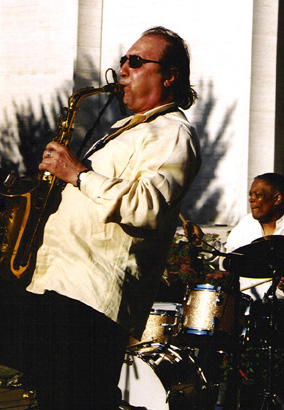 upper-range flights that stretch the limits of improvisation. For his
complex compositions and intense performances, he requires a group of like-minded
players, capable of listening closely and performing at the upper reaches
of technique.
upper-range flights that stretch the limits of improvisation. For his
complex compositions and intense performances, he requires a group of like-minded
players, capable of listening closely and performing at the upper reaches
of technique.
Such was the trio of musicians who accompanied Abate for a June 10 Jazz
in June appearance in Lincoln—versatile pianist Phil DeGreg, bassist Harvie
S and drummer Billy Hart. Several thousand listeners turned out to hear the
fireworks.
Hart set the tone with a drum introduction to Abate’s burner “Evolution,”
the title track from his most recent CD. Abate’s alto, soaring into the stratosphere
during his solo, was brought to earth by DeGreg’s lyrical keyboard work
and an inventive bass solo. Hart returned with explosive statements from
his drum kit.
DeGreg kicked off the next tune, “K.T. Blues,” with a powerful rubato.
Abate and Hart traded licks, with Hart establishing his trademark with unconventional
phrasing and percussive accents.
 The tempo slowed for the evergreen “I Can’t Get Started,” most memorable
for DeGreg’s flowing and imaginative piano lines. “Kerry’s Bossa” led off
with a bass cadenza and ended with a series of exhilarating double-time alto
sax runs by Abate. Ratcheting up the intensity even higher,
the quartet launched into “Bebop.” Abate set the fierce pace on alto as
Hart added sizzling cymbals and crackling rim shots. DeGreg’s propulsive
piano solo segued into a final series of drum breaks.
The tempo slowed for the evergreen “I Can’t Get Started,” most memorable
for DeGreg’s flowing and imaginative piano lines. “Kerry’s Bossa” led off
with a bass cadenza and ended with a series of exhilarating double-time alto
sax runs by Abate. Ratcheting up the intensity even higher,
the quartet launched into “Bebop.” Abate set the fierce pace on alto as
Hart added sizzling cymbals and crackling rim shots. DeGreg’s propulsive
piano solo segued into a final series of drum breaks.
From the book of standards came a mid-tempo version of “Joy Spring.” After
a lilting alto sax lead statement, DeGreg and Harvie S took energetic solos,
as if to illustrate the title’s irrepressible mood. Abate dedicated the romantic
ballad “The Nearness of You” to newlyweds Butch and Grace Berman.
Abate shifted into waltz tempo for his composition “Angelic,” a tribute
to his daughter, Jessica. In his sensitive piano solo, DeGreg deftly interpolated
a quote from “Softly, As in a Morning Sunrise.” Closing the performance in
fine fashion was the very fast “The Little Men,” dedicated to Abate’s sons,
Gregory and Anthony. Again, the alto sax and the piano took the spotlight
and the accolades.
top
Concert Review
Darryl White Sextet features special guests
|
By Tom Ineck
The June 17 appearance of the Darryl White Sextet for a performance at
Jazz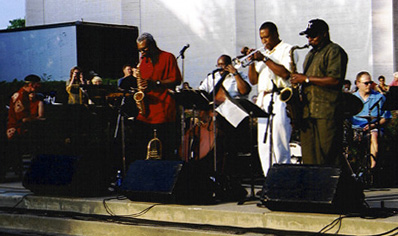 in June had been long anticipated for the inclusion of some very special
guests.
in June had been long anticipated for the inclusion of some very special
guests.
Professor of trumpet at the University of Nebraska-Lincoln, White brings
a considerable reputation to the table with his distinguished Denver-based
group of sidemen. But add Kansas City sax masters Bobby Watson and Gerald
Dunn, and you know you’re in for a treat.
White’s long-time associates included Denver pianist (and Nebraska native)
Jeff Jenkins, bassist Kenny Walker and drummer Matt Houston. Those who have
been listening to White’s CDs and performances over the last few years are
familiar with their talents, but Watson and Dunn changed that equation.
With a respectful nod to his deceased father, White began with a solo
trumpet introduction of “The Tree Has Fallen,” segueing into “A Cord of
Three Strands.” Watson demonstrated his unerring, powerful phrasing in an
alto sax solo utilizing a circular breathing technique to create a long,
intense passage. White’s own solo was followed by a very progressive keyboard
excursion by Jenkins.
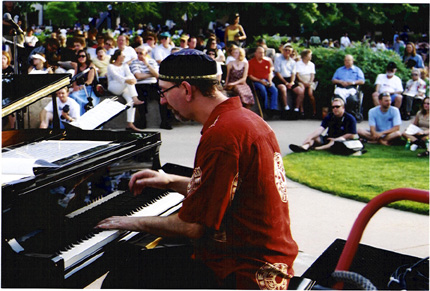 John McNeil’s composition “Abercrombie” featured White on flugelhorn in
a restful, meditative mood. Sensitive to that mood, Watson followed with
a moving alto solo and Jenkins delivered a searching piano foray. Gerald
Dunn’s brawny tenor solo contrasted nicely with Watson’s lighter, lyrical
touch.
John McNeil’s composition “Abercrombie” featured White on flugelhorn in
a restful, meditative mood. Sensitive to that mood, Watson followed with
a moving alto solo and Jenkins delivered a searching piano foray. Gerald
Dunn’s brawny tenor solo contrasted nicely with Watson’s lighter, lyrical
touch.
The title track from White’s latest CD, “In the Fullness of Time,” had
the ensemble stating the melody, leading to solo statements by White on trumpet,
Watson on alto, Jenkins on piano (who came up with some ingenious variations)
and Dunn on tenor. Wayne Shorter’s “United” had White back on flugelhorn,
Dunn delivering another big-toned solo and the three horns combining on
a climactic coda.
 Watson was placed directly in the performance spotlight for a stunning
rendition of “Easy Living,” backed only by the rhythm section. After
taking the first solo, Watson was visibly impressed by Jenkins piano solo,
returning for an alto cadenza that reached inspired heights of creativity. Watson was placed directly in the performance spotlight for a stunning
rendition of “Easy Living,” backed only by the rhythm section. After
taking the first solo, Watson was visibly impressed by Jenkins piano solo,
returning for an alto cadenza that reached inspired heights of creativity.
The sextet returned to earth and some very earthy sounds with Eddie Harris’
funky “Cold Duck Time.” Its simple riffing structure and good-time feel makes
it a perennial crowd-pleaser.
White’s composition “Nanpet (The Called of God)” is a platform for legato
phrasing by the ensemble and another notable piano solo. The funk returned
with the Mingus classic “Nostalgia in Times Square.” White, on flugelhorn,
joined with Watson and Dunn for a series of three-way trades.
From his debut CD “Ancient Memories” came the title track, which has the
timeless sound of a future standard. As is his wont, White ended with a powerful
performance of “When the Saints Go Marching In.”
top
Concert Review
Don Stiernberg delivers
mandolin swing
|
By Tom Ineck
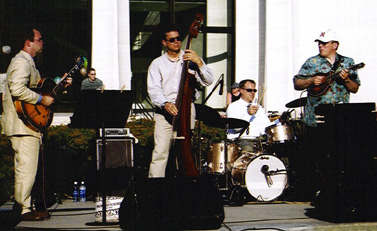 Backed by a superb jazz trio for his June 24 Jazz in June performance
in
Lincoln, mandolinist extraordinaire Don Stiernberg proved once and for
all that his instrument is not just designed for bluegrass music. Backed by a superb jazz trio for his June 24 Jazz in June performance
in
Lincoln, mandolinist extraordinaire Don Stiernberg proved once and for
all that his instrument is not just designed for bluegrass music.
Of course, that was never in doubt after hearing his CD “About Time,”
reviewed in the last issue of Jazz. But the message came across loud and
clear in live performance. Never straying too far from the standard jazz
repertoire, the Don Stiernberg Quartet was as comfortable with the changes
as any conventional bebop combo fronted by a saxophonist or trumpeter.
“Where or When” got things off to a flying start at a fleet tempo, with
sparkling solos by Stiernberg on mandolin and Kirk Morrison on guitar. The
Windy City-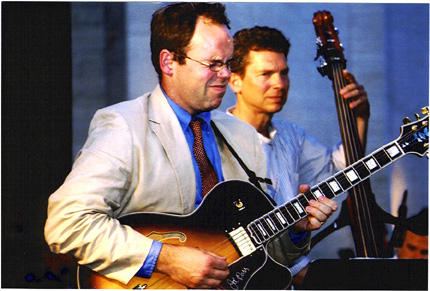 based group even interpolated a quote from “Chicago” in the coda
just to remind the audience where they are from. based group even interpolated a quote from “Chicago” in the coda
just to remind the audience where they are from.
“It Might as Well Be Spring,” taken at a medium tempo with a Latin tinge,
took Stiernberg and Morrison through the paces, and they displayed marvelous
dexterity. Bassist Jim Cox and drummer Kevin Connelly maintained a bedrock
rhythm for the Brazilian ballad “Estate (Summer).”
They drove the band on “Take Me Out to the Ballgame,” described by Stiernberg
as a “blues” number, especially for Chicago Cubs fans (nearly every year).
Stiernberg deftly traded fours with Cox, proving that rapid, single-note
runs on an instrument ordinarily used for percussive chording are no problem
for someone who knows his way around the mandolin this well.
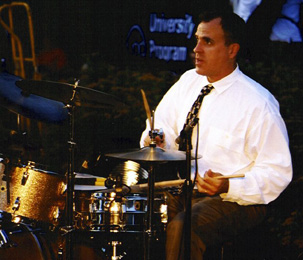 Hoagy Carmichael’s “New Orleans,” with vocal by Stiernberg, got a reading
as languid, lazy and luscious as the city for which it is named. The band
returned to the Latin tinge for a very sprightly version of “Brazil,” complete
with mandolin and guitar solos and imaginative drum breaks. The standards
kept coming with a mid-tempo “Let’s Get Lost” and a ballad take on “Polka
Dots and Moonbeams.” Hoagy Carmichael’s “New Orleans,” with vocal by Stiernberg, got a reading
as languid, lazy and luscious as the city for which it is named. The band
returned to the Latin tinge for a very sprightly version of “Brazil,” complete
with mandolin and guitar solos and imaginative drum breaks. The standards
kept coming with a mid-tempo “Let’s Get Lost” and a ballad take on “Polka
Dots and Moonbeams.”
The unlikely “Theme from Mannix” actually made a perfect vehicle for mandolin
and guitar improvisation. Even the hip-hop beat imaginatively applied to
the obscure Django Reinhardt tune “Sweet Atmosphere (Doux Ambiance)” failed
to do irreparable harm, and the band’s version of Harold Arlen’s “My Shining
Hour” was flawless.
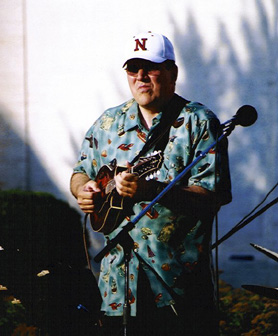 A serious musician, Stiernberg is not without a sense of humor, listing
some
of his favorite foods while singing “I Don’t Want Love,” as though gorging
one’s appetite could distract the mind from more romantic endeavors. On the
other hand, “Beautiful Love” was interpreted as pure romance. A serious musician, Stiernberg is not without a sense of humor, listing
some
of his favorite foods while singing “I Don’t Want Love,” as though gorging
one’s appetite could distract the mind from more romantic endeavors. On the
other hand, “Beautiful Love” was interpreted as pure romance.
Nearing the end of the well-received performance, Stiernberg turned to
Ellington for “Happy Reunion” and “Perdido” before returning to Reinhardt’s
songbook for the bopper “Belleville.”
top
Editor’s Note:
At your request, we will mail a printed version
of the newsletter. The online newsletter also is available at this website
in pdf format for printing. Just click here: Newsletter
|

 in the long and storied history of Kansas City jazz.
Nearly 30 of KC’s finest musicians gathered to perform a daylong benefit
at The Piano Room, a small club at 8410 Wornall Road in the city’s Waldo
district.
in the long and storied history of Kansas City jazz.
Nearly 30 of KC’s finest musicians gathered to perform a daylong benefit
at The Piano Room, a small club at 8410 Wornall Road in the city’s Waldo
district. Festivities began modestly at 2 p.m. with vocalist Julie Turner and Turner’s
son, Brian Ruskin, on guitar. As the day progressed, musicians wandered
in to take the stage, reaching a crescendo of formidable jazz expertise
by the early evening and continuing until the final jam had played out at
10 p.m.
Festivities began modestly at 2 p.m. with vocalist Julie Turner and Turner’s
son, Brian Ruskin, on guitar. As the day progressed, musicians wandered
in to take the stage, reaching a crescendo of formidable jazz expertise
by the early evening and continuing until the final jam had played out at
10 p.m. Ruskin is an outstanding guitarist, in both jazz and blues
styles, and a
sensitive accompanist to his mom on such
tunes as “Out of Nowhere,”
“Alone Together” and the samba “How Insensitive,” which was an excellent
vehicle for Turner’s throaty vibrato.
Ruskin is an outstanding guitarist, in both jazz and blues
styles, and a
sensitive accompanist to his mom on such
tunes as “Out of Nowhere,”
“Alone Together” and the samba “How Insensitive,” which was an excellent
vehicle for Turner’s throaty vibrato. Even before he took the stage to perform, traditional jazz pianist-singer
Bram Wijnands was enthusiastically documenting the historic event on his
video camera. His duo set with Scamps drummer Rusty Tucker was a joy, pitting
the young Dutch marvel with one of the elder statesmen of Kansas City jazz.
It was a hoot to hear Wijnands deliver a Dutch-inflected “She’s my ding
dong baby and she knows how to ring my bell,” then join Tucker for some
raunchy, blues tinged scat singing.
Even before he took the stage to perform, traditional jazz pianist-singer
Bram Wijnands was enthusiastically documenting the historic event on his
video camera. His duo set with Scamps drummer Rusty Tucker was a joy, pitting
the young Dutch marvel with one of the elder statesmen of Kansas City jazz.
It was a hoot to hear Wijnands deliver a Dutch-inflected “She’s my ding
dong baby and she knows how to ring my bell,” then join Tucker for some
raunchy, blues tinged scat singing. World,” but it was Wijnands’ Fats Waller-inspired playing
and singing on Waller’s “Honeysuckle Rose” that was most impressive. His
rollicking, wide-open keyboard attack had feet tapping and fingers snapping.
The duo also dedicated a sensitive version of “Sentimental Journey” to club
owner Dean Weiss, who generously contributed the day’s profits to Marillac.
World,” but it was Wijnands’ Fats Waller-inspired playing
and singing on Waller’s “Honeysuckle Rose” that was most impressive. His
rollicking, wide-open keyboard attack had feet tapping and fingers snapping.
The duo also dedicated a sensitive version of “Sentimental Journey” to club
owner Dean Weiss, who generously contributed the day’s profits to Marillac. Embrey, bassist Bob Bowman and drummer John Doubleday. Tunes included
an uptempo “Yesterdays,” “O Pato (The Duck),” and a reprise of “All the Things
You Are.” Embrey was loath to leave early, but he was due to board a flight
the next morning to join singer Karrin Allyson for a European tour that
included stops in Rome and Paris.
Embrey, bassist Bob Bowman and drummer John Doubleday. Tunes included
an uptempo “Yesterdays,” “O Pato (The Duck),” and a reprise of “All the Things
You Are.” Embrey was loath to leave early, but he was due to board a flight
the next morning to join singer Karrin Allyson for a European tour that
included stops in Rome and Paris. bassist Gerald Spaits and drummer Ray DeMarchi, a very compatible trio
of veterans. Never satisfied with conventional interpretations, Cartwright
and company chose a samba by trumpeter Claudio Roditi and the underappreciated
standard “Whisper Not,” before putting a definitive blues tinge to the
timeless ballad “September Song,” building to the astonishing piano crescendo
and the soulful climax for which Cartwright has become known.
bassist Gerald Spaits and drummer Ray DeMarchi, a very compatible trio
of veterans. Never satisfied with conventional interpretations, Cartwright
and company chose a samba by trumpeter Claudio Roditi and the underappreciated
standard “Whisper Not,” before putting a definitive blues tinge to the
timeless ballad “September Song,” building to the astonishing piano crescendo
and the soulful climax for which Cartwright has become known.  Kansas City legend Pete Eye replaced Cartwright at the piano for a stunning
rendition of Paul Desmond’s “Take Five.” Eye’s affinity for Dave Brubeck
was immediately evident in his classical constructions and syncopated phrases.
Kansas City legend Pete Eye replaced Cartwright at the piano for a stunning
rendition of Paul Desmond’s “Take Five.” Eye’s affinity for Dave Brubeck
was immediately evident in his classical constructions and syncopated phrases.
 Irwin, the lively “Lester Leaps In.” The classic bop changes received
a round of exemplary solos by Kessler, Park and Cartwright, each one building
in intensity and innovation and ending with Park mimicking Lester Young’s
famous sideways stance and Kessler valving the trumpet upside down!
Irwin, the lively “Lester Leaps In.” The classic bop changes received
a round of exemplary solos by Kessler, Park and Cartwright, each one building
in intensity and innovation and ending with Park mimicking Lester Young’s
famous sideways stance and Kessler valving the trumpet upside down! As the evening began to wind down, pianist and singer Mike Ning took
the stage with bassist Tim Brewer and drummer Mike Shanks for yet another
version of “All the Things You Are,” followed by “Everything Happens to
Me.” Sherry Jones capably vocalized on the uptempo “Ornithology/How High
the Moon,” on which Ning’s solo cleverly referred to “Surrey with The Fringe
on Top.” Young aspiring drummer Timothy Ning made it a family affair when
he joined dad Mike and mom Sherry for a rhythmic run through the Herbie Hancock
favorite “Watermelon Man.”
As the evening began to wind down, pianist and singer Mike Ning took
the stage with bassist Tim Brewer and drummer Mike Shanks for yet another
version of “All the Things You Are,” followed by “Everything Happens to
Me.” Sherry Jones capably vocalized on the uptempo “Ornithology/How High
the Moon,” on which Ning’s solo cleverly referred to “Surrey with The Fringe
on Top.” Young aspiring drummer Timothy Ning made it a family affair when
he joined dad Mike and mom Sherry for a rhythmic run through the Herbie Hancock
favorite “Watermelon Man.” Richter and bassist Brian Hicks for Bobby Timmons’ “Moanin’” and another
rendition of “Centerpiece,” which also featured Park on alto sax.
Richter and bassist Brian Hicks for Bobby Timmons’ “Moanin’” and another
rendition of “Centerpiece,” which also featured Park on alto sax. The day’s events stand as a remarkable example of artistic camaraderie
and might serve as a model for Marillac’s vision statement: “To see at-risk
children and families become contributing members in their communities
by modeling a caring, nurturing and learning environment and by providing
innovative, professional treatment and support.”
The day’s events stand as a remarkable example of artistic camaraderie
and might serve as a model for Marillac’s vision statement: “To see at-risk
children and families become contributing members in their communities
by modeling a caring, nurturing and learning environment and by providing
innovative, professional treatment and support.” “Books, Ballads and Bebop” certainly created a caring, nurturing
and learning
environment for the hundreds of jazz fans who turned out to support
a very worthy cause.
“Books, Ballads and Bebop” certainly created a caring, nurturing
and learning
environment for the hundreds of jazz fans who turned out to support
a very worthy cause. exhilarating expression of emotions. At its best, it is poetry in motion
and a panoramic parade of life’s joys and sorrows.
exhilarating expression of emotions. At its best, it is poetry in motion
and a panoramic parade of life’s joys and sorrows. a short residency and workshops
with students with a concert for a very enthusiastic crowd.
a short residency and workshops
with students with a concert for a very enthusiastic crowd. The trio of Capers, Robinson and Williams then played “Everything Must
Change.” Although I was a little hesitant at the announcement of this really
overworked number, it took on a whole new life with Caper's great version.
Moving from a Bill Evans feel on the theme, she took it into an up-tempo
modal section interlude after the bridge that was really refreshing.
The trio of Capers, Robinson and Williams then played “Everything Must
Change.” Although I was a little hesitant at the announcement of this really
overworked number, it took on a whole new life with Caper's great version.
Moving from a Bill Evans feel on the theme, she took it into an up-tempo
modal section interlude after the bridge that was really refreshing. up-tempo “From This Moment On.” She then sang Strayhorn's
melancholy “Lush Life,” followed by “Nature Boy,” two ballads that picked
up slightly during a rich Given's solo on the latter.
up-tempo “From This Moment On.” She then sang Strayhorn's
melancholy “Lush Life,” followed by “Nature Boy,” two ballads that picked
up slightly during a rich Given's solo on the latter. down the house again, and only my fatigue kept me from sticking
around for the encore.
down the house again, and only my fatigue kept me from sticking
around for the encore. Since the mid-1990s, the Jamaica-born composer, bandleader and
percussionist Norman Hedman has been captivating audiences with the
warmth and insistent rhythms of his tropical jazz juggernaut, Tropique.
Since the mid-1990s, the Jamaica-born composer, bandleader and
percussionist Norman Hedman has been captivating audiences with the
warmth and insistent rhythms of his tropical jazz juggernaut, Tropique. Tropique’s sound remains consistent, despite the departure of a couple
of its longtime members, a tribute to Hedman’s vision and leadership.
Tropique’s sound remains consistent, despite the departure of a couple
of its longtime members, a tribute to Hedman’s vision and leadership. From the 1996 CD “Healing Hands,” the ballad “Forever” proved its timeless
quality. Again, it utilized a doubled melody line of alto sax and flute,
providing the basis for solos by both Tsyganov brothers. Special guest vocalist
Ada Dyer joined the group for “Closer.” Renowned for her work with pop artist
Sting and in the musical “The Wiz,” Dyer brings a huge voice—with soul
and gospel influences—to the stage, a nice contrast to Tropique’s lighter
approach.
From the 1996 CD “Healing Hands,” the ballad “Forever” proved its timeless
quality. Again, it utilized a doubled melody line of alto sax and flute,
providing the basis for solos by both Tsyganov brothers. Special guest vocalist
Ada Dyer joined the group for “Closer.” Renowned for her work with pop artist
Sting and in the musical “The Wiz,” Dyer brings a huge voice—with soul
and gospel influences—to the stage, a nice contrast to Tropique’s lighter
approach. But the tribute to Butch and Grace had only begun. Dyer returned to sing
the
beautiful “Angel of the Night,” written by Hedman in
honor of the Berman nuptials. Hedman announced that it will be included
on his next CD, to be called “Because I Can.”
But the tribute to Butch and Grace had only begun. Dyer returned to sing
the
beautiful “Angel of the Night,” written by Hedman in
honor of the Berman nuptials. Hedman announced that it will be included
on his next CD, to be called “Because I Can.” upper-range flights that stretch the limits of improvisation. For his
complex compositions and intense performances, he requires a group of like-minded
players, capable of listening closely and performing at the upper reaches
of technique.
upper-range flights that stretch the limits of improvisation. For his
complex compositions and intense performances, he requires a group of like-minded
players, capable of listening closely and performing at the upper reaches
of technique. The tempo slowed for the evergreen “I Can’t Get Started,” most memorable
for DeGreg’s flowing and imaginative piano lines. “Kerry’s Bossa” led off
with a bass cadenza and ended with a series of exhilarating double-time alto
sax runs by Abate. Ratcheting up the intensity even higher,
the quartet launched into “Bebop.” Abate set the fierce pace on alto as
Hart added sizzling cymbals and crackling rim shots. DeGreg’s propulsive
piano solo segued into a final series of drum breaks.
The tempo slowed for the evergreen “I Can’t Get Started,” most memorable
for DeGreg’s flowing and imaginative piano lines. “Kerry’s Bossa” led off
with a bass cadenza and ended with a series of exhilarating double-time alto
sax runs by Abate. Ratcheting up the intensity even higher,
the quartet launched into “Bebop.” Abate set the fierce pace on alto as
Hart added sizzling cymbals and crackling rim shots. DeGreg’s propulsive
piano solo segued into a final series of drum breaks. in June had been long anticipated for the inclusion of some very special
guests.
in June had been long anticipated for the inclusion of some very special
guests. John McNeil’s composition “Abercrombie” featured White on flugelhorn in
a restful, meditative mood. Sensitive to that mood, Watson followed with
a moving alto solo and Jenkins delivered a searching piano foray. Gerald
Dunn’s brawny tenor solo contrasted nicely with Watson’s lighter, lyrical
touch.
John McNeil’s composition “Abercrombie” featured White on flugelhorn in
a restful, meditative mood. Sensitive to that mood, Watson followed with
a moving alto solo and Jenkins delivered a searching piano foray. Gerald
Dunn’s brawny tenor solo contrasted nicely with Watson’s lighter, lyrical
touch. Watson was placed directly in the performance spotlight for a stunning
rendition of “Easy Living,” backed only by the rhythm section. After
taking the first solo, Watson was visibly impressed by Jenkins piano solo,
returning for an alto cadenza that reached inspired heights of creativity.
Watson was placed directly in the performance spotlight for a stunning
rendition of “Easy Living,” backed only by the rhythm section. After
taking the first solo, Watson was visibly impressed by Jenkins piano solo,
returning for an alto cadenza that reached inspired heights of creativity. Backed by a superb jazz trio for his June 24 Jazz in June performance
in
Lincoln, mandolinist extraordinaire Don Stiernberg proved once and for
all that his instrument is not just designed for bluegrass music.
Backed by a superb jazz trio for his June 24 Jazz in June performance
in
Lincoln, mandolinist extraordinaire Don Stiernberg proved once and for
all that his instrument is not just designed for bluegrass music. based group even interpolated a quote from “Chicago” in the coda
just to remind the audience where they are from.
based group even interpolated a quote from “Chicago” in the coda
just to remind the audience where they are from. Hoagy Carmichael’s “New Orleans,” with vocal by Stiernberg, got a reading
as languid, lazy and luscious as the city for which it is named. The band
returned to the Latin tinge for a very sprightly version of “Brazil,” complete
with mandolin and guitar solos and imaginative drum breaks. The standards
kept coming with a mid-tempo “Let’s Get Lost” and a ballad take on “Polka
Dots and Moonbeams.”
Hoagy Carmichael’s “New Orleans,” with vocal by Stiernberg, got a reading
as languid, lazy and luscious as the city for which it is named. The band
returned to the Latin tinge for a very sprightly version of “Brazil,” complete
with mandolin and guitar solos and imaginative drum breaks. The standards
kept coming with a mid-tempo “Let’s Get Lost” and a ballad take on “Polka
Dots and Moonbeams.” A serious musician, Stiernberg is not without a sense of humor, listing
some
of his favorite foods while singing “I Don’t Want Love,” as though gorging
one’s appetite could distract the mind from more romantic endeavors. On the
other hand, “Beautiful Love” was interpreted as pure romance.
A serious musician, Stiernberg is not without a sense of humor, listing
some
of his favorite foods while singing “I Don’t Want Love,” as though gorging
one’s appetite could distract the mind from more romantic endeavors. On the
other hand, “Beautiful Love” was interpreted as pure romance.